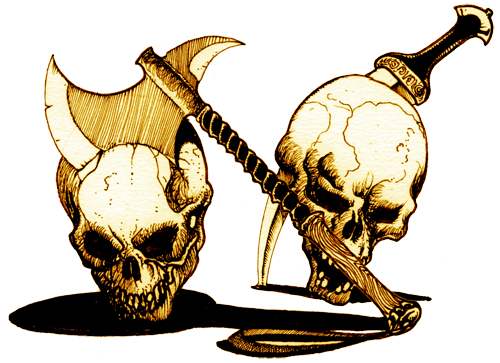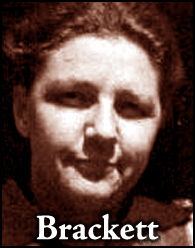The Cimmerian V3n12 — December 2006

Edited by Leo Grin | Illustrated by Dalmatius
40 pages
This issue was printed in two editions. The deluxe edition, numbered 1–75, uses a black linen cover with foil-stamped gold text. The limited edition, numbered 76–225, uses a gold cover with solid black text.
DELUXE COPIES DESTROYED: 13
LIMITED COPIES DESTROYED: 66
Features a fascinating essay on Howard’s poetic and mythic techniques, an article about a semi-famous, strange Howard fan, a piece delving into the convoluted history of the Howard copyrights and REH publishing, more details about the new Robert E. Howard Foundation, the thunderous end to Richard Tierney’s year-long sonnet cycle, letters, art, and more.
EXCERPTS:
We now come to a supreme epic device: the pathetic fallacy, which I prefer to call the meteorological punctuation. This is an effect — spelled out strongly on the stage — whereby the weather or other heavenly phenomenon is often correlated closely with the hero’s actions, his moods, and their consequences. It comes in especially well when correlated with the break of day, or above all with a sunset, and can serve to mark the finale of some interior act with due solemnity. We have become so many times over-accustomed to this device, and moreover have seen how too easily it lends itself to parody, that we tend to forget how very effective it proves when utilized with taste, skill, and sincerity.
The single most striking example of Howard’s use of the pathetic fallacy is found in one of his single most imaginative and powerful stories, the aptly titled “Kings of the Night.” King Kull of Atlantis emerges from an incredibly distant past to fight all day alongside fellow barbarians, only then returning to his own faraway existence. But it is Howard’s unique manner of transporting Kull to and from Bran Mak Morn’s contemporary world that captures and holds our attention, and fires our imagination.
— from “Robert E. Howard: Epic Poet in Prose” by Donald Sidney-Fryer
Even in his own time Howard was not neglected — a young Robert H. Barlow wrote asking for his autograph, and perhaps one of the most bizarre of his admirers was a Weird Tales reader whom Howard referred to as “that fool Olson,” in a letter to Tevis Clyde Smith. Whoever Olson was he seems to have had a mental deficiency, as he apparently wrote many strange letters to Weird Tales authors. In the same letter to T. C. Smith Howard writes, “This time he’s frothing at the mouth on account of my ‘Horror from the Mound.’ He lashed himself into a perfect frenzy because I said a vampire was really dead. He says that there is no death in the first place, and that Christ was a vampire.” Obviously Olson was a few cards short of a full deck.
— from “Diary of a Bad Man” by Brian Leno
Two years later, on November 12, 1944, Dr. Howard died of a heart attack at the age of seventy-three. His remains were laid to rest with his wife and son in the family plot at the Greenleaf Memorial Cemetery in Brownwood. For the kindness and care he had received, he left all that he owned to his benefactor Dr. Kuykendall. Among his possessions were a few thousand dollars in a bank account, a collection of Robert’s magazines, letters and papers, and the rights to Robert’s literary work. In his will, Dr. Howard had left instructions that a trunk full of Robert’s papers should be forwarded to E. Hoffmann Price in California. According to correspondence between Price and August Derleth, the trunk was shipped soon after Dr. Howard’s death and received by Price.
— from “Legacy” by Leon Nielsen
We have plans to establish scholarships and grants for scholars in the fields that Howard mined — fantasy, adventure, pulps, etc. — and for young writers in those genres. The future may see writers’ workshops and other activities, depending upon resources. We hope some of the grants will encourage the presentation of papers on Howard at conferences such as Popular Culture Association meetings, or the International Conference on the Fantastic in the Arts.
— from “The Robert E. Howard Foundation” by Rusty Burke
Now in the twilight of Hyborian fame
A sadness settles down upon all things.
Gone are the days of great heroic kings,
Their cities ravaged and destroyed in flame.
— from “The Doom of Hyboria” by Richard L. Tierney
I don’t agree, however, that Skull-Face was a slow seller — not when what we know is factored in with a reasonable expectation of the demand for, and potential sales of, such a book. Lovecraft was a very small name when Derleth published The Outsider and Others, and that book was considered a slow seller by Derleth, though there were hardly any norms to go from in 1939. That’s because the Lovecraft book was a “best of” collection full of stories its “market” had already read in the pulps, though at least some of the stories were a decade or more old. This fact limited sales. Remember Derleth’s surprise when Beyond the Wall of Sleep — filled with less familiar fare — sold out in a quarter of the time? Derleth knew he was marketing to readers who already read Howard in Weird Tales. Derleth knew, too, that he was returning to the extra-large omnibus format of those Lovecraft volumes, and that the higher price would make the book less attractive to Arkham readers not already familiar with Howard. Finally, Derleth knew Howard was a smaller fish than Lovecraft in the same small pond — but he nevertheless tripled the number of copies printed. None of these things mattered — Derleth was producing a book for posterity. With all of this in mind, what does it say that Skull-Face sold through nearly three times the number of copies as The Outsider did, in less than three times as long?
— John Haefele, writing in The Lion’s Den




